In the media, attention was focused more on preparations for International Women’s Day and the #9M Women’s Strike. The official number of confirmed cases in Mexico was still minimal, but Tec de Monterrey could already see what was coming: the impact of the coronavirus and the preventative measures to be taken.
Beatriz Palacios, director of Educational Innovation, says they began preparing for a critical situation and drawing up a contingency plan.
“At that point, a week before March 9, we started planning to decide what we would say to teachers, what they needed to know at a minimum, what technological tools we could use to deal with it,” she says.
On March 12, the Tec announced that, although there were still no COVID-19 cases in its community, it was suspending face-to-face classes at high school, university, and postgraduate levels beginning March 17 and initiating virtual online academic continuity programs on the 23rd. It was the first Mexican university to declare an emergency for its academic community.

The reason for this was to prevent what was already coming, as well as to reduce the social impact of mobility at the institution, which has 26 campuses throughout the country.
Over the course of the following days, other universities such as UDEM, U-ERRE, UVM, UANL, Ibero, UNAM, ITAM, IPN, BUAP, Anáhuac, and Universidad Panamericana would join the list. Weeks later, basic education in the country would also be suspended.
The Tec understood the magnitude of this challenge. In the words of David Garza, the Tec’s rector at the time and its president beginning July 1, the institution was facing one of its biggest challenges in the area of online learning, as well as in the midst of the global crisis.
“Next Monday, March 23rd, we begin the Flexible Digital Model that will offer academic continuity to more than 90,000 students at university, postgraduate, and high school levels. Each week, more than 55,000 class sessions will be taught by 10,000 teachers. This is the size of the challenge we face today,” he said.
He then added: “Teachers and collaborators have worked hard, making the extra effort to adapt their courses and to have the right support material for this method. It will certainly be one of the biggest efforts in the history of online learning on our continent.”
"It will certainly be one of the biggest efforts in the history of online learning on our continent.” David Garza, Rector's Tec.
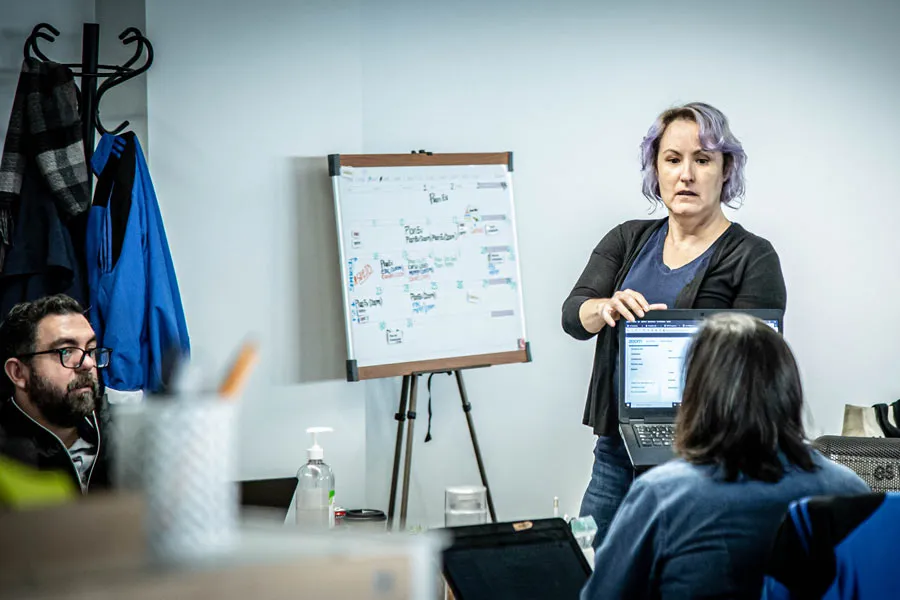
The creation of its distance learning model, which the Tec called the Flexible Digital Model (Modelo Flexible Digital, MFD), was the answer to allowing the institution, according to its balance sheets and analysis, to maintain its classes at a fairly acceptable level with the that it had.academic challenges
Over the week leading up to the launch, 100 percent of its teachers were trained through 290 workshops. They were trained to take advantage of the institution’s proven and already utilized technologies, such as Zoom, CANVAS, and Blackboard, as well as other apps, to transform their courses for the digital context and to design and integrate active learning activities.
Teachers had a self-diagnosis tool to detect their needs, as well as the provision of resources to cover them; and pedagogical guidance and supportive educational technology; as well as the experiences of teachers who had knowledge and practice in the digital format.
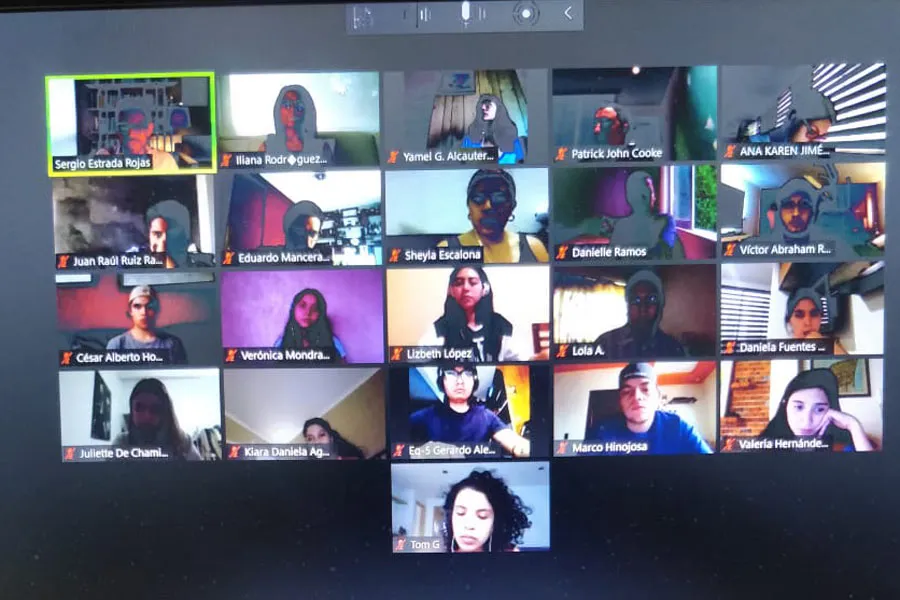
Melissa Garza, a graduate student in Communications and Digital Media at the Monterrey campus, says she was initially affected by the cancelation of face-to-face classes because it made her realize the gravity of the problem. However, she was grateful to be studying at an institution that has the infrastructure to deal with this situation.
“I know that not everyone has these opportunities and time is very valuable. I thank the Tec because we didn’t lose the semester. We were able to continue, and the classes were adapted so that we could learn”, she says from her home in Saltillo.
“I was really surprised by the Tec’s level of response because everything was very quick, teachers were trained, and students as well, which helped teachers.”
Among the strategies carried out by the institution was the preparation of more than a thousand “Academic Buddies”, professors and collaborators who were trained to support teachers during their Zoom sessions.
“I was really surprised by the Tec’s level of response because everything was very quick, teachers were trained, and students as well, which helped teachers.” Melissa Garza, student.
APART FROM THE CLASSES... THE STUDENT EXPERIENCE
Online and distance education for all students continued through to the end of the semester, due to the Healthy Distance Program being extended and predictions for the coronavirus infection curve in several cities.
Against this background, the Tec decided to reinforce its model in April with new elements that will provide the community with not only the academic aspect, but also options for other activities such as sports and cultural events from home and even wellness and mental, emotional, medical, and nutritional health support in a more standardized and broad way for its community on all campuses in Mexico.
This more robust model was then called Flexible Digital Model Plus, which focused on providing more complete experiences to the community, beyond just classes.
“What started out as an Emergency Remote Teaching program quickly evolved into this more complete model with different experiences for our students,” explains David Garza in interview.

The Flexible Digital Model Plus was launched with six main pillars:
- Academic Continuity 2.0, which provides more resources for distance learning
- Life@Home, which includes art, culture, sport, and entertainment activities and courses
- Taking Care of Your Mind, which provides resources and activities for emotional and mental well-being
- Boost Your Skills, which offers courses, programs, and certificates from the world’s best universities to develop more personal and professional skills
- Tec Value Benefits, which provides promotions for Tec community support through providers and partners, as well as a platform to publish the services and products of family businesses
- Tec Community Link, which promotes social activities to help in the midst of this situation
“I feel that even though we are at a distance, they want to make your experience the same as if you were on campus,” says Omar Moreno, a student at the Monterrey campus, who has used these resources from his home in Tampico.
“Sometimes I feel anxious, and I’ve gone to watch videos and there are experts who help you deal with it. I feel like it’s helped me discipline myself a lot.”
This refers to the materials that the Tec also created as part of its support for the community through the Taking Care of Your Mind pillar, in addition to maintaining its 24-hour helpline where it provides expert advice on emotional, mental, medical, and nutritional health for its students and collaborators.

David Garza points out that the institution’s emphasis was on the personal and going beyond just the academic curriculum to seek students’ integral adaptation and to maintain the community.
“We are in High-Tech times, but High-Touch is also needed for our students. We have demanded a lot and made teachers aware of the emotional aspect of our students, telling them: bear in mind everything they are experiencing right now.”
“They may have relatives who are suffering and the simple fact that at their ages they are living through this... we have to not only teach a class but also help them as role models in terms of how to handle this situation and to encourage them a lot.”
THE TEC’S EXPERIENCE HELPED
Although the vast majority of university institutions in the world had to migrate to an emerging distance learning model, the Tec has leveraged its distinction in the distance learning and educational innovation experience that it has accumulated over three decades.
What’s more, Tec de Monterrey celebrated 30 years of distance and digital learning last year, and scheduled conferences and published a book to mark the occasion, with evidence on several key topics: such as that the Tec created the first Internet connection in Latin America.
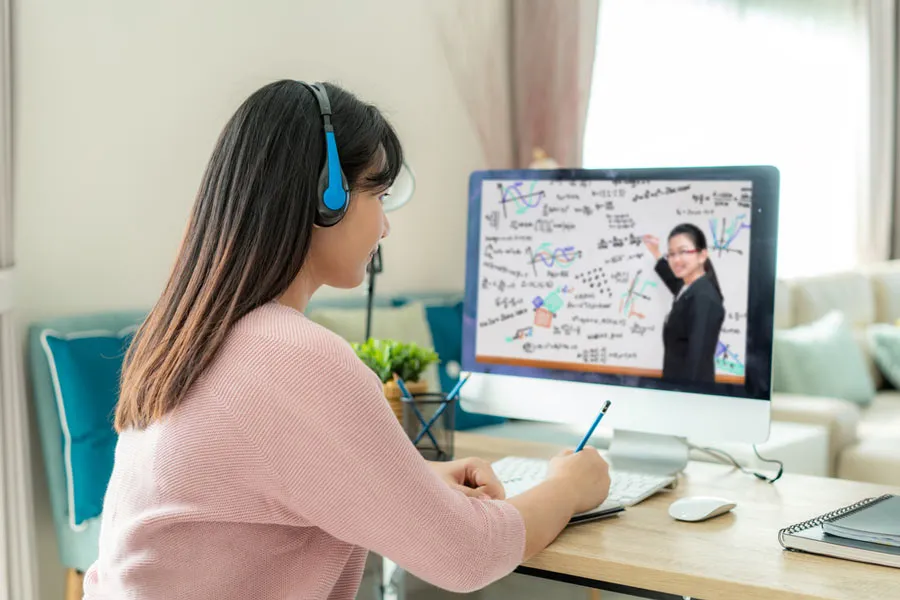
“At the Tec, we have a background in distance learning: in 1966, we taught our first class on television. And, as a point of reference: the first television class in the world was in 1965,” says David Garza.
“We had a Virtual University, we have educational innovation, we had the unfortunate experience of the earthquake that prepared us for an experience like this. How did all this help us? It helped in the training and preparation of our teachers and in pedagogical aspects.”
On the Tec’s Educational Innovation page, which is open to the public, the institution now offers a comprehensive guide with resources for teachers to successfully transform their courses into flexible and digital ones.
One example of this type of adaptation is what Artemisa Sangermán, PrepaTec teacher and director of the Department of Spanish and Literature, has done since 2017. After the earthquake in Mexico City, she opened a YouTube channel to create educational content and hasn’t stopped making videos, which have been used on other campuses.
“They cover different types of learning so that kids pay attention. The videos also include some exercises, and this is why it takes me time to do them. I write the scripts and produce them. These materials have crossed borders,” she shares with CONECTA, the Tec’s news site.
In addition to these experiences, the other pillar that, in David Garza’s opinion, has enabled successful academic continuity online has been the quality of the teachers.
One example of this is Dr. Iliana Rodríguez Santibáñez, a professor of law at the Mexico City campus, who demonstrated that a Zoom class doesn’t have to be boring, with a teacher talking all the time and showing slides, but can appeal to interest and can connect.
“I take real satisfaction in the fact that there hasn’t been a single student absent in any of my sessions,” she says.
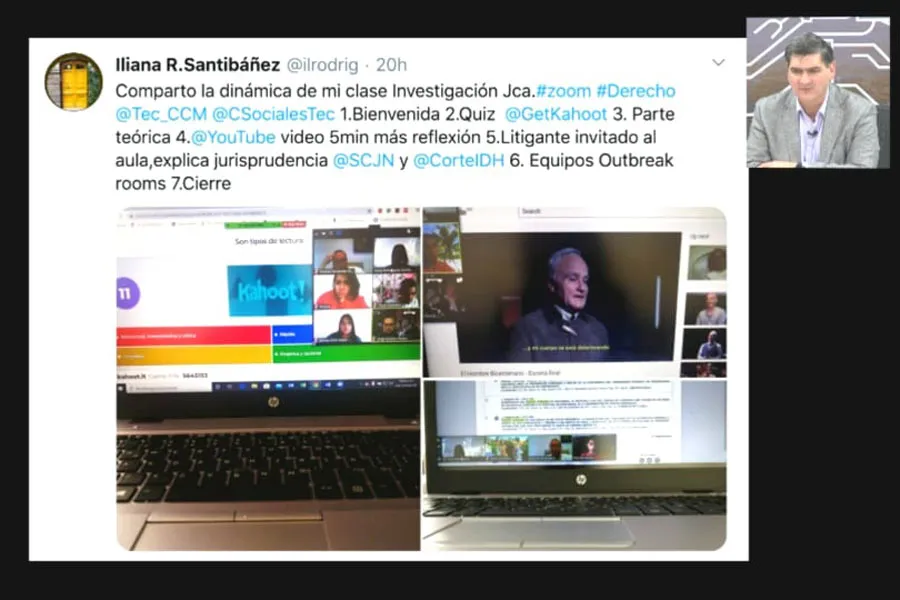
She began by welcoming students and encouraging them to interact. One day, she even invited students to include a photo of the place they wanted to travel to in their Zoom background, which led to a friendly conversation about young people’s desires and experiences.
On the theoretical side, she used applications to give students pop quizzes to measure their learning. Her students could interrupt and ask questions. She included a 3- to 4-minute video and then they worked in teams in Zoom’s Breakout Rooms solving the cases she assigned them.
In each session, she had an expert guest, including Mariana Salazar Albornoz, a member of the Inter-American Legal Committee of the OAS; Sergio Estrada Rojas, director of the Diplomatic Academy of the Matías Romero Institute; and the attorney at law Vicente Fernández.
“They become very stimulating classes for students with different resources,” she says enthusiastically.
The teacher also encouraged a master’s student in international law to take her master’s exam via Zoom on April 2, the date she had been assigned before the cancelation of face-to-face activities.
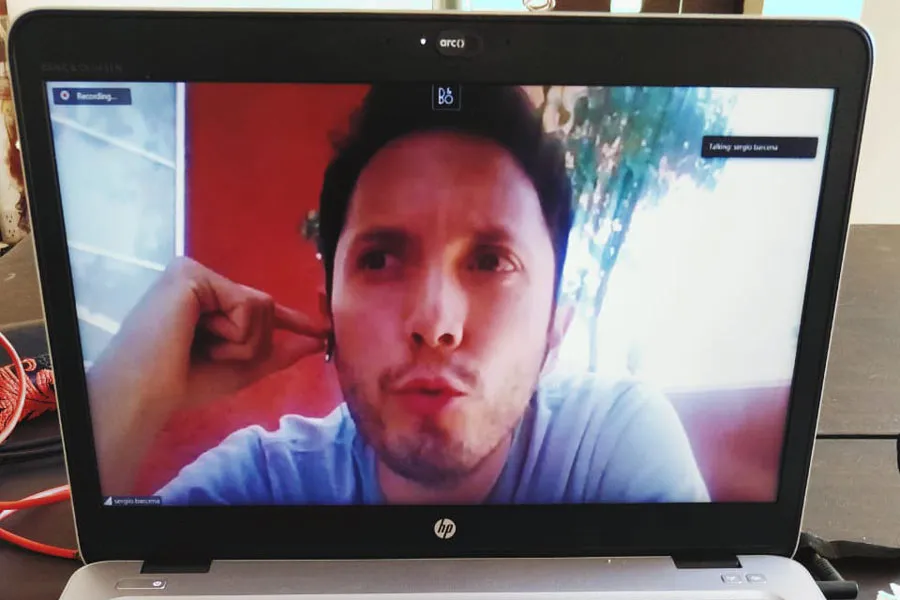
Diana Brito was looking forward to presenting her thesis on the vulnerability and violation of the human rights of migrants to the examination committee, and after passing her examination, she excitedly said online: “fortunately, we already have technological developments we can use for whatever need exists, and the Tec has always been at the forefront in that aspect.”
Joaquín Guerra, Assistant Director of the Tec’s Academic and Educational Innovation, agrees that teachers are key to the Tec model.
“The main factor is that we have teachers who have reminded us at this moment that education, teaching is a vocation, and it is a love for doing something for someone,” he said during the Best Practices in the Transition to Online Learning webinar, organized by the Hemispheric University Consortium in May.
“The main factor is that we have teachers who have reminded us at this moment that education, teaching is a vocation, and it is a love for doing something for someone.”
For Guerra, as well as the doctors at the Tec and other institutions who have been the heroes in health matters, at the Tec the heroes have also been the teachers, who have trained and made an effort to adapt.
“Regardless of the obstacles and circumstances around us, they have come through because the last thing a teacher can do is stop teaching.”
Another example of innovation is demonstrated by Professor Diana Urquiza, Director of Musical Production Studies at the Mexico City campus, who, together with her students, innovated to bring the face-to-face experience of audio labs to digital classes.
Urquiza and Mijael Gutiérrez, Director of these studies at the Santa Fe campus, applied for licenses from software manufacturers on the Tec’s behalf and then made tutorial videos for the students.
“The speech was: learn how to set up your computer to stream your audio with the best possible quality, which is challenging. Being like this encourages the students to do their best and say: I have to share the audio with my teacher and my classmates, and it has to be heard well.”
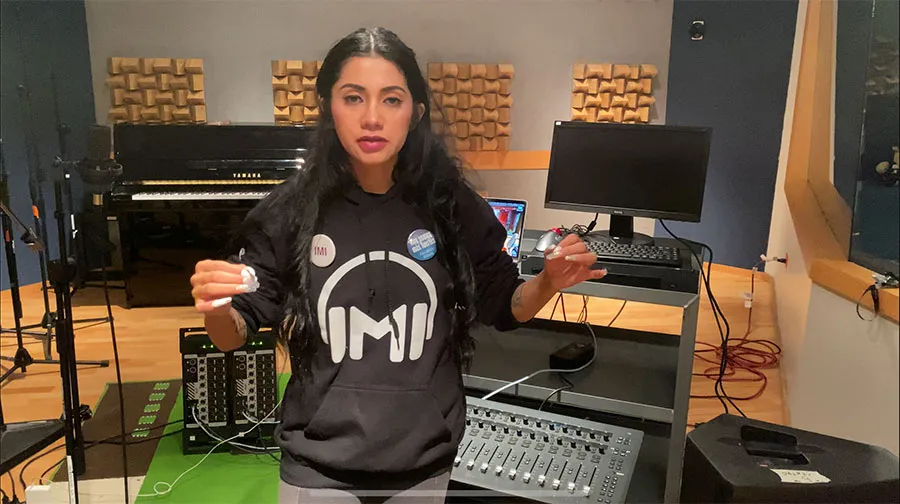
Urquiza, who teaches post-production and digital mastering classes, says that students entered a state of continuous stimulation as they had to give their best version of the musical product. She gave them a theoretical introduction of 15 minutes, explained how to do things, assigned them a micro challenge in a three-hour class, and at the end had a feedback review.
“We accompanied the students throughout on technological matters that allowed us to take the classes to a good level of quality. Many students report that they can even focus better in some of our music production classes because they can listen carefully to the audio and the teacher focuses a lot on the product the student makes.”
INTO THE FUTURE
David Garza takes a positive view of the operation of the model, after being aware of the views of the students through surveys: “In the face of the situation that has been extended much longer than expected, there are very good levels of satisfaction with what our teachers are doing with the Flexible Digital Model”.
Palacios sees that it was the Tec’s work to ensure academic continuity that has also let learning continue to take advantage of even more technology and hybrid teaching models.
“It’s a dream come true to see that our institution really took advantage of distance learning in this situation and that it has helped our institution remain afloat and that its students don’t lose their classes,” she says.
“It’s a dream come true to see that our institution really took advantage of distance learning in this situation and that it has helped our institution remain afloat and that its students don’t lose their classes.”
Community students, such as marketing student Karina Rosas, have also shared discoveries at this social juncture. “This quarantine taught me that the truth is the online class method works very well for me personally. I think I’ll do a master’s online,” she wrote on her Twitter account.
After evaluating the experience in this first part of the year, Garza sees that the traditional class model won’t disappear at the Tec, but the school will begin to add more elements of distance learning.
“Students are realizing that there is a lot of flexibility when they’re able to take courses this way, from wherever they are, with any teacher. We can further enhance the national capabilities the Tec de Monterrey has, as well as international capabilities.”
The COVID-19 coronavirus emergency has changed the world. Within these transformations, the experience of a flexible and digital model like the Tec’s will also undoubtedly have an impact on education.
Palacios hopes that teachers can see that all the digital tools they are using at this moment of crisis can enrich their teaching practice in the future: “We can’t talk about two extremes; we have to talk about a single world where the digital part converges to enrich face-to-face experiences.”
With information from Rebeca Ruiz

THE SIX PILLARS OF THE FLEXIBLE DIGITAL MODEL PLUS
Academic Continuity 2.0
Tools and technology needed to enhance development, including virtual laboratories, online digital library, and online librarian support; ongoing training for teachers; and accompanying and advisory website so that students can answer all their questions about the services and resources that exist for their learning and distance experience.
Life@Home
More than 1,200 activities and daily online classes that promote comprehensive well-being; sporting events and competitions; and free health, music, art, leadership, psychology, and wellness courses.
Taking Care of Your Mind
Information and resources to promote emotional health. These provide free psychological, medical, and nutritional counseling; personalized assistance to each student with mentors, advisors, and department directors; and support materials.
Boost your skills
Partnerships with Coursera and EdX provide access to courses, specialized programs (MOOCs) and certificates from the best universities in the world that complement learning, develop skills, and provide certification.
Tec value benefits
Prices, benefits, packages, and preferential discounts to support your financial situation as much as possible. In addition to having a platform that allows you to share and publish services and products about family businesses in the Tec community.
Social impact actions
More than 100 actions undertaken by various members of the Tec community to meet the challenges presented by the emergency. A space to share, connect, and enhance these projects, as well as place high value resources at the service of the community in general.
ACCUMULATED CLASS SESSIONS
- March 23 - April 23, 2019
- 179,889 class sessions
- 99.9% average of sessions without incident impacting students
- Schedules with up to 1,400 simultaneous sessions
ALSO READ:





